Do: Pick a Solution that Meets Your Needs
In the Monty Python classic Life of Brian, the main character tells an assembled crowd, 'You are all individuals.' They respond in unison, 'We are all individuals.' Yet, it’s true: no two companies are alike.
When it comes to cloud data architecture, the approach one firm chooses isn’t necessarily the best decision for another. A successful deployment of cloud data architecture involves gaining a deep, thorough understanding of what your business needs.
Don’t: Forget about Compliance
Whatever data architecture or data warehouse solution you choose, you absolutely can’t neglect compliance. Today, there are a number of data security and privacy regulations. Even if you’re located outside of the jurisdiction where those regulations originated, they still may apply to you.
When you use cloud services, you don’t directly bear the burden of compliance; rather, your cloud services provider does. However, that doesn’t mean you’re off the hook. If you choose a cloud services provider who doesn’t comply with regulations, you could find yourself paying hefty fines.
Do: Think Strategically
Another question to ask yourself is, 'How does cloud data architecture fit into our overarching business strategy?' There’s a danger in new technology: corporate decision makers see it and think, ‘Oh, it’s new—we have to have it so we stay ahead of the competition.’ However, that doesn’t necessarily mean that whatever new technology they’re using makes sense for the company.
The cloud has any number of use cases that may make sense for your business; what matters is that those use cases drive your business forward rather than hold you back.
Don’t: Rest on Your Laurels
Don’t think that because you’ve implemented a cloud data architecture or data warehouse that you’ve reached the peak of cutting-edge technology. You’re actually only just getting started.
Even though the cloud is becoming a well-established part of the enterprise technology landscape, it’s still an emerging technology. Vendors are still developing new and interesting ways to use the cloud, some of which might help you run your business better. Don’t ignore them after you’ve deployed a cloud data architecture or data warehouse.
Do: Think about Security
As we mentioned earlier, one of the benefits of the cloud is that it removes some of the burdens that were traditionally placed on the IT department. One of those burdens is security—the cloud services provider is responsible for that.
However, as with compliance, you need to pick a vendor that takes security very seriously. If a third party has poor security practices and you suffer a data breach, you’ll suffer the consequences (which could include fines as well as damage to your reputation).

Don’t: Let Expectations Run Wild
Unless the decision maker has deep technical knowledge, chances are very good that he or she doesn’t understand how the cloud works or what it can do for your firm. By the same token, these people have also heard why the cloud is great, and they might be advocating a move to the cloud without a clear idea of what that means.
Setting expectations is crucial. You have to explain what it means to move into the cloud, what the benefits are, but also what costs you’ll bear during this process. The cloud isn’t a magic ticket to business success in and of itself—it’s the way you use it.
Do: Pay Attention to Legacy Systems
You may be moving to the cloud, but that doesn’t necessarily mean you’re abandoning your legacy systems. In fact, you’re most likely not—they store valuable information.
A cloud data warehouse or cloud data architecture will probably need to draw from those legacy systems so that it can process, analyse, and serve up information. As such, your legacy systems will need to connect with those new technologies. Before implementing anything new, check how your old systems are configured so that they can ‘talk’ to your new software.
Don’t: Assume Everything is Fine
This point is connected to the one we made about not resting on your laurels. In this section, we’ll tell you why you can’t take a 'set-it-and-forget-it' attitude to cloud data architecture.
Just because you’ve implemented cloud data architecture doesn’t mean that it’s working the way it’s supposed to, or that users are getting the promised benefits from it. Cloud data architecture and data warehouses need to be monitored so that the IT department knows if they’re working as they ought to.
Do: Choose the Right Cloud Services Provider
There’s competition within the cloud services provider market. How do you know you’re making the right choice?
Microsoft Azure is an established, trusted cloud services provider with a wide variety of cloud offerings. Azure is one of the most secure cloud computing services on the market, having obtained 70 compliance certificates and attestations from countries, regions, and industries.
Another benefit of using Azure is that it’s part of the Microsoft family of products. As Microsoft has some of the most widely used enterprise applications, it’s easy to integrate Azure into much of what you’re already using.
Don’t: Go It Alone
What if you don’t have the internal resources to implement a cloud data architecture or a cloud data warehouse? Turning to a trusted, experience partner solves the problem.
The right partner takes the time to understand your requirements and workflows. They want to build a long-lasting relationship—you’re not just a number. Moreover, you can depend on them—they’re not going to leave you high and dry.
Enlighten: Helping You Transition to a Cloud Data Architecture
Since 1998, Enlighten has specialised in maximising clients’ data. We’re a proud Microsoft partner, having achieved Gold status in Data Platforms and Analytics. To learn more, contact us.

